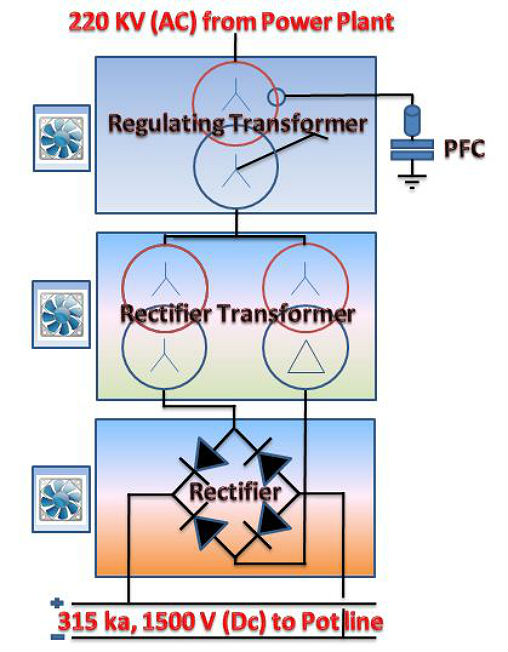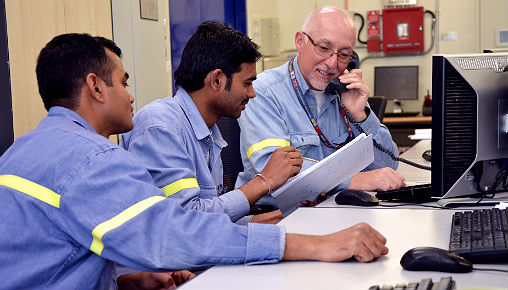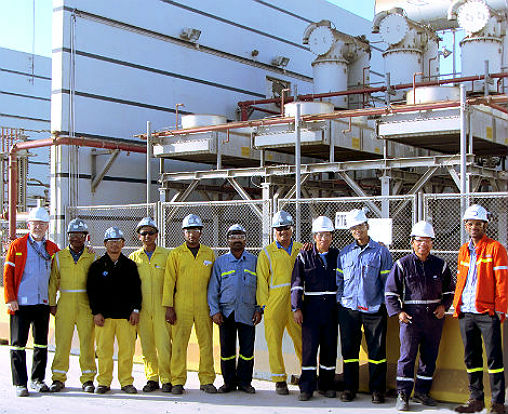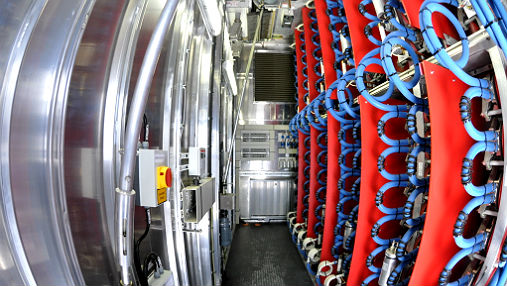Aluminium production requires a high DC current through the Reduction cells. The Qatalum Power Plant generates 1,350 MW, at 220 kV that needs to be regulated and converted from AC to DC power. A group of 10 Rectiformers accomplish this task.
Located on the end of each Potroom, each 'Rectiformer' group consists of a Regulating Transformer, a Rectifier Transformer, a PFC (Power Factor Correction) and a Rectifier – the collective term used in the industry is 'Rectiformer'. The Rectifiers is a one of the most critical systems for the operation of an aluminium smelter. The availability and uptime of the Rectifiers is extremely important to be able to have stable operation of the potlines.

Diagram showing the functionality and components that make up a Rectiformer
This high voltage equipment is monitored from the CCR (Central Control Room) located at the Service Center.

Inside the control room
A dedicated team of 2 HV technicians, a Specialist and an Engineer plus 4 HV operators are responsible for the operation and maintenance of the equipment.

The dedicated Rectifier maintenance team in front of a Rectiformer. Rectifier team with Qcon personnel. From left to right: Richard Guignard (HV-Rectifier Specialist, Deepak Swain (Rectifier Technician), Alok Mihir (Rectifier Technician) with the Qcon personnel. Absent on the picture: Mohandas Polekar (Rectifier Engineer)
The main KPI measuring the effectiveness of the tasks accomplished by this team, is to measure the Kilo Amps per hour (kA/h) loss in the Reduction cells through the year. At present Qatalum's average Potline current is at 314 kA. During the last 2 years, no loss were recorded from the Rectiformers. "The value determining the lack of Kilo Amp loss is considered at the world's lowest level for any smelter and reflects directly the thorough management and maintenance of Qatalum's Rectiformers," said Richard Guignard, HV and Rectifier Specialist in the Power Group.
To be able to achieve this level of reliability, the following 2 criteria have to be met: Maintenance and Improvement
Maintenance
Each Rectiformer is shut down annually for maintenance. The Qatalum Rectifier Team, with the help of sub-contractors Qcon, accomplishes this task with encouraging results.
The in-house servicing has resulted in a significant reduction of alarms and trips during the year and an increase in knowledge, therefore strengthening the follow-up of modifications and improvements.

Inside a Rectiformer cubicle where AC power is converted into DC. Visible are the Diode Bridge with the blue pipes used for cooling
Improvement
Stability in the form of dependability in providing flawless operation is the key factor to the client, Reduction. To provide this, several modifications have been made to improve the reliability and safety. The Rectifier team has accomplished as many as 28 major modifications to the system, with a remaining seven ongoing. The modifications have been done on different sub-systems of the Rectifier and include for example, transformer protection and the rectifier protection of capacitor banks and cooling systems.
Cooling: Since we are located in a hot climatic zone, effective cooling is critical. The control systems have been modified on many levels to improve the efficiency of the equipment. One example is to run all the available heat exchangers during the summer peak period.
Current stability: During a power fluctuation from the Power Plant, the Rectiformers need to rapidly control the current to the potline in order to prevent an overload leading to a shut down. During load shedding, abnormal fluctuation of up to 20 megawatts can occur, creating a huge stress to the pot lines. Therefore, the logic in the control systems have been improved to cancel this fluctuation and provide the cells with constantly optimal energy in a short time.
Short-circuit risks in the Rectiformers: One main issue observed since the start-up is the high risk of short-circuiting from water entering the Rectifier cubicles and through the main bus bars. Many solutions were proposed by external service providers, but since the potline can't be de-energised, the Rectifier team has brought some simple and low cost solutions into action. Non-conductive reinforced fibre glass has been installed over the DC buss-bar of each Rectiformer, preventing water contact with high voltage components and removing the risks of a short circuit. This will prevent any damage to major equipment, and therefore prevent production loss.
Rune Kristoffersen, HV Distribution and Rectifier Manager, Power Plant says, "The Rectifier Team have, since start up, been able to achieve close to 100% uptime of the rectifiers without any loss of kA in the potlines. This achievement is based on high competence among the members and systematic development of the maintenance plans. They have implemented a culture of continuous improvement supported by Reliability Centre Maintenance (RCM) and Qatalum Production System (QPS) tools. This way of working will secure a stable operation at the lowest cost possible for years to come."

